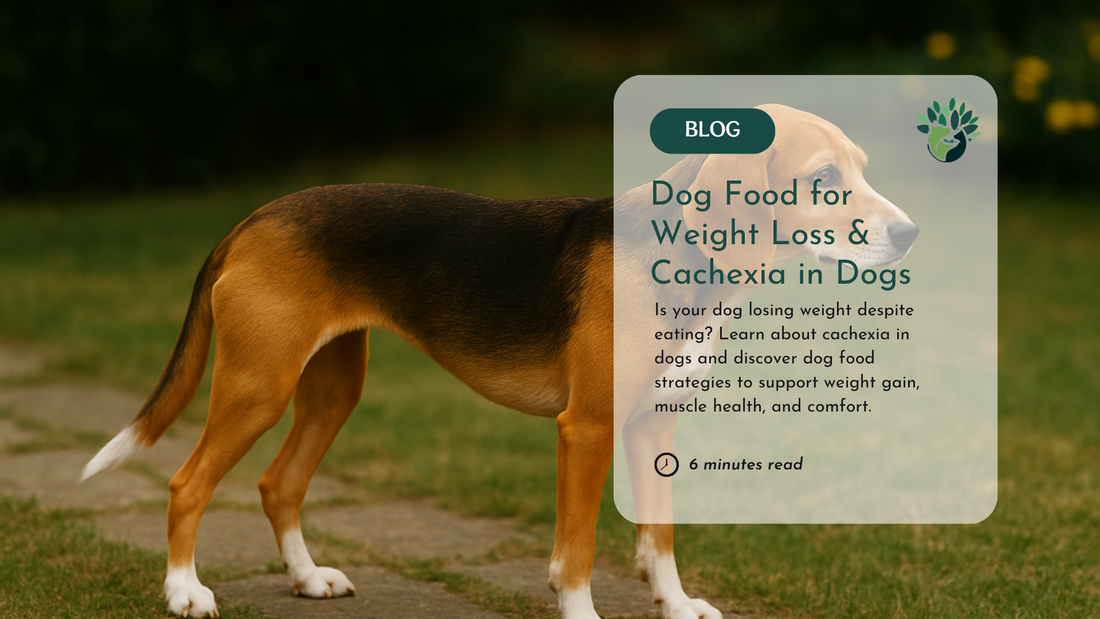If your dog has been diagnosed with a chronic illness, you’re likely doing everything you can to keep them comfortable, well-fed, and feeling loved. But when they start turning away from food or begin to lose weight, it can feel both confusing and heartbreaking. You might find yourself wondering what you’re doing wrong, but please know, you’re not. Appetite and weight changes are common in dogs facing long-term illness, and they’re often part of the body’s complex response to disease—not a reflection of your care.
This article is here to help you understand what’s really going on when chronic illness affects your dog’s appetite and weight. We’ll break down the common causes, explain a more serious condition called cachexia, and guide you through gentle, nutrition-focused ways to support your dog’s strength, comfort, and quality of life.
Why Chronic Illness Affects Your Dog’s Appetite and Weight
Watching your dog lose interest in food or drop weight when they’re already dealing with a chronic illness can be incredibly hard. As a pet parent, it’s natural to feel helpless or worried, but these changes aren’t your fault, and they’re not your dog “being picky.” They’re often part of how the body responds to long-term illness.
Understanding what’s going on beneath the surface can help you respond with more confidence and compassion. Here are some of the common reasons dogs lose their appetite and struggle with weight during illness:
Inflammation and Immune Response
When your dog’s body is fighting something serious, their immune system produces inflammatory molecules (like cytokines) to help. But these molecules can also suppress appetite. It’s the body’s way of shifting focus to healing, saving energy that would normally go toward digestion. Over time, though, this can lead to unwanted weight loss.
Nausea and Discomfort
Many chronic conditions cause nausea, vomiting, or tummy troubles. Understandably, when your dog feels sick to their stomach, food is the last thing on their mind. Liver and kidney issues, for example, can lead to toxin buildup that causes nausea, making it even harder for them to eat.
Energy Imbalance
Illness puts extra demands on your dog’s body. Even if they seem to be eating a little, it may not be enough to meet those higher energy needs. When that happens, the body starts to break down fat and eventually muscle to keep going. This is one of the main reasons weight loss happens, especially in long-term conditions like diabetes or cancer.
Hormonal Changes
Certain diseases throw off hormone levels that affect hunger and metabolism. Some conditions, like Addison’s disease or hypothyroidism, may cause gradual weight loss. Others, like Cushing’s disease, might lead to weight gain even if your dog isn’t eating more than usual. These changes can be confusing, but they’re not uncommon.
Pain and Stress
Pain, whether from arthritis, dental problems, or something else, can make eating difficult or unpleasant. And emotional stress, even if it's subtle, can impact your dog’s appetite too. Illness itself, vet visits, or changes in routine can all add up and take a toll.
Medications and Treatments
Some medications your dog may need, like antibiotics or chemotherapy, can bring side effects like nausea, diarrhea, or a change in how food tastes or smells. On the other hand, drugs like steroids can make your dog ravenous and lead to unwanted weight gain. Every treatment journey is different, and it’s okay to adjust things along the way.
Cachexia in Dogs
When a dog is living with a long-term illness, weight loss is common, but in some cases, it becomes more than just eating less. This more serious condition is called cachexia (pronounced kuh-KEK-see-uh), and it’s a complex syndrome that goes beyond simple weight loss.
What Is Cachexia?
Cachexia is a form of severe muscle wasting that often occurs alongside serious health conditions like cancer, kidney failure, heart disease, or diabetes. Unlike regular weight loss—where the body uses stored fat for energy—cachexia causes the body to break down muscle tissue, even when food is available and fat stores remain.
This happens because chronic illness triggers the body to release inflammatory chemicals (called cytokines), stress hormones (like cortisol), and other metabolic disruptors. These substances interfere with how the body processes nutrients, making it difficult to properly use protein and fat. As a result, even a dog who is eating well—or receiving supplemental nutrition—can continue to lose muscle and become weaker.
How Does It Happen?
-
Chronic inflammation disrupts how the body normally processes nutrients.
-
Appetite may decrease due to nausea, stress, or internal chemical changes.
-
Muscle starts breaking down to meet the body’s increased energy needs.
-
Fat stores may still be present, but the body favors muscle breakdown instead.
-
Over time, visible muscle loss and fatigue set in—even if your dog is still eating.
How to Spot Cachexia at Home
Pet parents are often the first to notice subtle changes. Early signs of cachexia can include:
-
Visible muscle loss, especially along the spine, shoulders, hips, and thighs
-
Weight loss that continues despite regular or increased feeding
-
Lethargy or weakness—your dog may tire more easily or show less interest in activity
-
A bony appearance, even if their belly seems full or slightly rounded
-
Changes in appetite, such as eating less or becoming pickier
-
Poor coat condition or slow healing from wounds or illness
It's important to remember: cachexia isn’t caused by neglect or feeding the wrong food. It’s the body’s internal response to disease, and it often requires more than just extra calories to address.
Healing Through Nutrition: Dog Food for Weight Loss
Cachexia is a serious condition, but it doesn’t mean you have to give up hope. With the right care, many dogs can still enjoy their days, stay comfortable, and share special moments with you. One of the best ways you can support your dog is through food. When weight loss is caused by a serious illness, offering nutritious, easy-to-digest meals can help keep their strength up, support their immune system, and give them the energy they need. The good news is—your care and attention really can make a difference. With some simple changes and a lot of love, you can help your dog feel better and more supported every step of the way. Here's how you can start.
Prioritize High-Quality Protein and Amino Acids
Protein is critical for maintaining muscle mass, especially in dogs experiencing muscle wasting due to serious illness like cachexia. These dogs often need up to 40% more protein than healthy dogs just to avoid further muscle loss. That may sound like a lot, but it can make a meaningful difference in your dog’s strength, energy, and overall comfort.
To help meet their needs, focus on easily digestible, high-quality protein sources such as:
-
Cooked chicken, turkey, or fish
-
Eggs
-
Cottage cheese (if tolerated)
-
Organ meats like liver (in moderation)
Adding key amino acids like leucine, lysine, and arginine can provide even more support. These nutrients don’t just help maintain muscle—they’re also essential for a strong immune system. Amino acids are the building blocks of immune cells and antibodies, which means they play a vital role in helping your dog fight off abnormalities in their body and work toward a more stable, balanced condition.
Incorporate Healthy Fats
Fat is an excellent energy source for dogs dealing with abnormal cell growth, especially when weight gain is a goal. It’s calorie-dense, meaning your dog can get more energy in smaller portions—without the insulin spikes that can come from carbohydrates.
To support your dog’s energy and overall health, focus on healthy fats such as:
-
Fish oil (rich in omega-3s like EPA and DHA)
-
Coconut oil (in small amounts)
-
Animal fats from high-quality meats
Omega-3 fatty acids are especially helpful—they support the body’s natural anti-inflammatory response and may even help slow down unwanted cell changes over time. For best results, aim for a balanced ratio of omega-3 to omega-6 fatty acids—ideally 1:1 or lower—to help create a more supportive internal environment for healing and stability.
Use Low-Glycemic Carbohydrates
While some suggest cutting out carbs completely, controlled amounts of low-glycemic carbohydrates can still offer valuable energy, without feeding abnormal cell growth. These types of carbs are digested more slowly, which helps avoid sharp insulin spikes.
Supportive options include:
-
Sweet potatoes
-
Pumpkin
-
Quinoa
-
Green vegetables like broccoli or spinach
It’s best to steer clear of high-glycemic carbs like white rice or corn, as they can raise insulin levels quickly and may influence unhealthy cell activity. With the right balance, low-glycemic carbs can help keep your dog energized without compromising their overall wellness.
Add Digestive Support
Abnormal cell growth—and the treatments used to manage it—can really upset your dog’s digestive system. It can damage the gut lining, throw off the balance of good bacteria, and make it harder for your dog to absorb important nutrients. That’s why keeping the gut healthy is so important.
Here’s how you can help:
-
Probiotics: These add good bacteria back into the gut to support digestion and overall health.
-
Digestive enzymes: Help your dog break down food better so they can actually use the nutrients they’re eating.
-
Fiber: Keeps the digestive system running smoothly and supports the good bacteria in the gut. It also helps strengthen the gut lining and boost the immune system. Natural options like pumpkin or psyllium husk are great choices.
Consider Appetite Stimulants
As mentioned above, serious illnesses can cause loss of appetite due to inflammation, nausea, or just feeling unwell, it’s not a behavior issue or your dog being picky.
If your dog is having trouble eating, here are a few gentle ways to help:
-
Warm up their food to make it smell more appealing.
-
Offer tasty, easy-to-digest foods like cooked chicken or plain baby food (make sure it doesn’t contain onion or garlic).
-
Ask your vet about appetite boosters like mirtazapine or CBD oil, which may help encourage eating when nothing else works.
Certain herbs and holistic remedies can gently support your dog’s appetite and help soothe an upset stomach. Here are a few gentle, vet-approved choices to consider:
-
Slippery Elm: This soothing herb forms a natural gel-like coating in the digestive tract, which can help protect irritated tissues and ease discomfort. It’s often used for pets with sensitive stomachs, mild diarrhea, or nausea, and can also encourage more consistent eating by making digestion feel more comfortable.
-
Ginger: Known for its anti-nausea effects, ginger can help settle the stomach and stimulate appetite. It supports gentle digestion and may reduce vomiting or queasiness, especially helpful if your pet is avoiding food due to nausea.
-
Chamomile: Widely used for its calming properties, chamomile can help relax both the digestive system and the nervous system. It may ease mild bloating, cramping, or indigestion, and can also help reduce stress or anxiety that might be affecting your dog’s appetite.
Supplement Wisely
Supplements can be a helpful part of your dog’s care during this difficult phase. The key is to start slow and focus on essentials that support their overall health and comfort. Some good options to consider include:
-
Fish oil – A great source of omega-3s that support the immune system and help calm inflammation.
-
Multivitamins – To fill in any nutritional gaps, especially if your dog isn’t eating as much as usual. A comprehensive option like Holistic Total Body Support (HTBS) can be particularly helpful because it’s designed to provide a balanced blend of essential vitamins, minerals, and glandular support to promote overall wellness. It’s a simple way to ensure your dog gets the nutrients they need, even during challenging times.
-
Milk thistle – Often used to support liver health, especially during times of stress or medication use.
-
Turmeric – Known for its natural anti-inflammatory effects that may help ease discomfort.
-
Zinc – Some studies show dogs with serious illnesses like lymphoma and osteosarcoma tend to have low zinc levels. Zinc plays a key role in immune support, cell repair, and antioxidant defense. It should only be given under your vet’s guidance.
-
Vitamin D – Low vitamin D levels have been linked to certain conditions, including lymphoma and mast cell tumors. While the ideal dosage is still being studied, maintaining healthy levels through balanced nutrition is encouraged.
Remember, always consult your vet before starting any new supplements. When it gets approved, best to introduce supplements one at a time to monitor how your dog responds.
Hydration is Key
When dogs are dealing with aggressive abnormal cell growth, staying hydrated becomes even more important, especially if they’re also experiencing vomiting, diarrhea, or a reduced appetite. Dehydration can sneak up quickly and make your dog feel even weaker, affecting everything from digestion to kidney function.
Make sure fresh water is always available and encourage drinking throughout the day. You can also boost hydration by adding moisture to meals. Try mixing in bone broth (unsalted and free from onions or garlic) or including water-rich vegetables like zucchini or cucumber. Not only does this help with hydration, but it can also make meals more appealing for dogs who aren’t feeling their best. Keeping your dog well-hydrated supports overall comfort, energy levels, and recovery.
Home-Cooked Diets
If you’re open to cooking for your dog, a home-cooked diet can be a powerful way to support their unique health needs. The CrockPet Diet, which I developed, is a great starting point. It’s built around whole, fresh foods and can be easily adjusted to include more protein and healthy fats, especially helpful for dogs dealing with muscle loss or serious illness.
One of the biggest benefits is flexibility, you can tailor every ingredient to support your dog’s condition and comfort level. If you’d like, a holistic pet health coach can walk you through how to adapt The CrockPet Diet recipe specifically for your dog’s situation.
Final Thoughts
Caring for a dog with a chronic illness is never easy, but your love, attention, and willingness to learn make all the difference. Appetite loss and weight changes can feel overwhelming, but they’re not something you have to face alone. By understanding what’s happening inside your dog’s body and making thoughtful, supportive choices, especially around nutrition, you’re giving them the best possible chance to feel stronger, more comfortable, and more like themselves.
Every small step you take, from adjusting meals to offering gentle supplements or simply being present, is an act of healing. And while you can’t control everything, your care truly matters. Stay kind to yourself, trust your instincts, and keep leaning into the bond you share with your dog. You're doing an incredible job, and they know it.
















